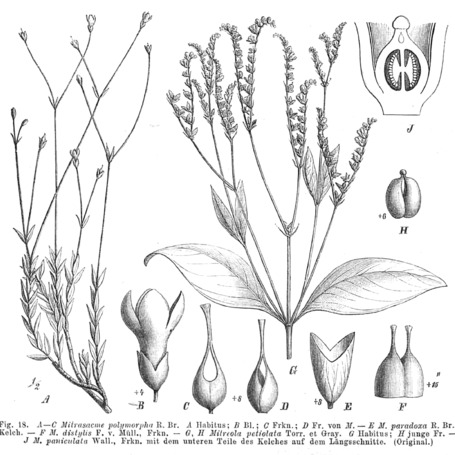Herbs, annual and erect or perennial and creeping at the base. Leaves petioled or sessile; interpetiolar stipules well developed or reduced to a transverse ridge. Inflorescences terminal and/or axillary, usually long-peduncled, dichasial with long cincinnate branches. Flowers on short pedicels to subsessile, 5-merous. Calyx almost parted to the base. Corolla urceolate, lobes short, imbricate in bud, mouth closed by a dense ring of hairs. Stamens short, included; anthers introrse, cells free. Pistil semi-inferior; ovary 2-celled, each cell with many, small, anatro-pous ovules; styles 2, short, sometimes absent; stigmas more or less adnate to each other. Capsules 2-horned, rarely globular, almost free from the calyx, both carpels dehiscent along the ventral suture. Seeds ∞, small, with fleshy endosperm.
Erect annual or creeping perennial herbs. Leaves entire, petiolate or sessile; stipules well-developed or reduced to a transverse ridge. Inflorescence terminal and/or axillary, dichasial with long 1-sided botryoidal branches. Flowers bisexual. Flowers 5-merous. Calyx lobes scarcely united; outer surface glabrous or minutely papillose. Corolla urceolate, with penicillate hairs or pilose ring in throat; lobes imbricate, slightly shorter than or equal to tube, papillose. Stamens inserted near corolla base; filaments glabrous, less than or equal to anther length. Ovary semi-inferior; ovules c. 30; style split from base at anthesis; stigma subcapitate or bilobed. Fruit a capsule, 2-horned or bilobed. Seed verrucose, reticulate or smooth.

